Teplyakova Olga
The children and I decided to prepare our own attributes for autumn-themed games. To do this, the children painted leaf patterns of three different trees: maple, birch and oak. Everyone chose a piece of paper for himself, which one he would like to color. After that, we began to learn games where we directly used colored leaves.
Mobile game "Leaf fall"
Tasks: improve the ability to perform movements in the text of the poem, develop memory, attention. consolidate knowledge about the signs of autumn.
Game progress: children hold their leaflet in their hand and stand in a circle. In the course of reading the poem, they wave the leaves and at the end throw them up, imitating leaf fall.
The wind is blowing, the wind is blowing
Blowing, blowing
yellow leaves
Breaks from the tree.
The leaves were flooded with sunshine.
The leaves are soaked in the sun.
Poured, weighed down
And they flew with the wind.
Falling, falling leaves
Leaf fall in our garden...
yellow, red leaves
They curl in the wind, they fly.
Mobile game "Autumn Bouquet"
Tasks: improve the ability to differentiate the leaves of different trees, develop observation, attention.
Game progress: Children stand in a circle, leaves in the center. To the music, the children move in a circle. The music stops, each child chooses a piece of paper. Children with leaves of one tree make up an autumn bouquet, pronouncing which tree the leaves are from. Next, the children put the leaves in a circle and the game starts again.
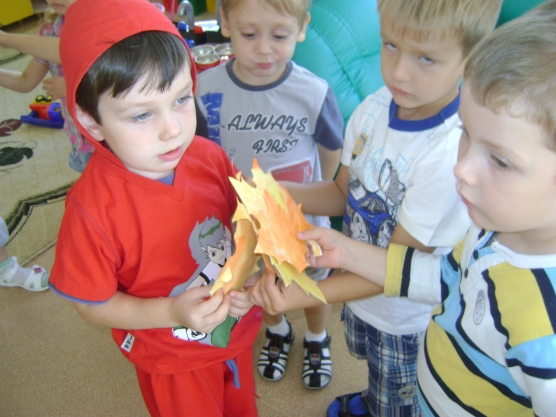
Mobile game "Find a Pair"
Tasks: learn to make pairs of leaves according to one feature indicated by adults, consolidate knowledge about shape, color and size, develop auditory and visual perception.
Game progress: children stand in a circle, in the center there are leaves (their number is according to the number of children and the leaves are selected so that pairs of leaves can be made). Children go in a circle with the words: “One, two, three - take the sheet as soon as possible!” Everyone takes a leaf. The teacher says: "Find yourself a pair - a leaf of the same color." (Other tasks: make a pair of leaves from the same tree, or leaves that differ
size: big and small, or leaves of the same size from one tree.)
Note: for this game, you need to prepare additional leaves from double-sided colored paper of a smaller size compared to those that the children painted.

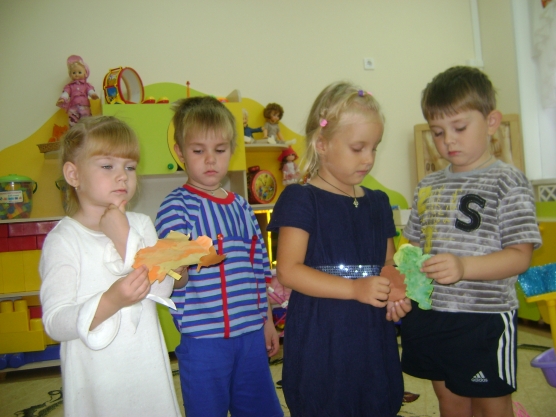
Didactic game "From which tree is the leaf?"
Tasks: improve the ability to differentiate trees by their trunks and leaves, develop attention, observation, memory, imagination.
Attributes: painted on separate sheets of trunks of three different trees, autumn leaves these trees.
Game progress: loose leaves lie around the drawings of tree trunks. The children have to place the leaves on their tree.
Note: the game can be played in group and individual form.
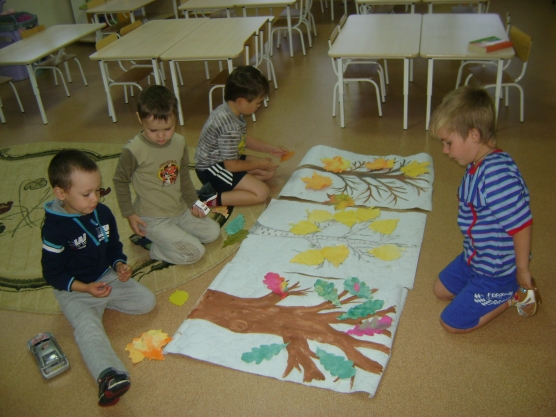
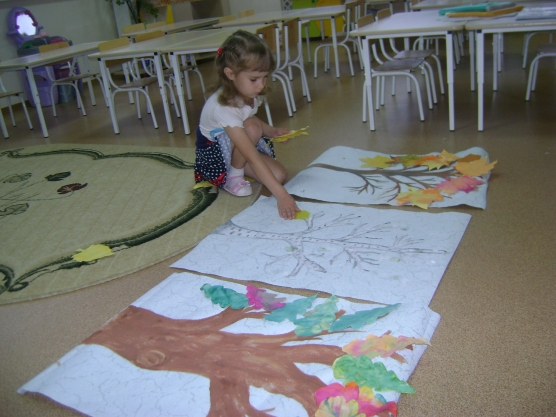
Didactic game "Which leaf?"
[Tasks: improve knowledge to distinguish the leaves of three trees, learn to form adjectives, develop oral speech, attention, memory.
Game progress: Children sit in a circle and pass each other a basket. In turn, they take out a leaf, say what tree it is from and form an adjective. For example: this is a birch leaf - a birch leaf.
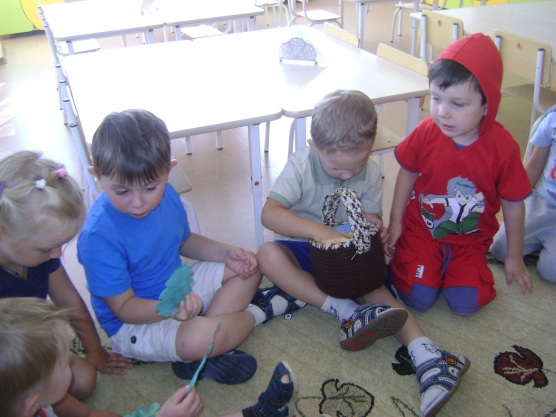
Mobile game "Listen carefully"
Tasks: develop the ability to follow verbal instructions, act on the signal of an adult, consolidate knowledge about the shape of the leaves of different trees.
Attributes:autumn leaves three types trees. The number of leaves of each tree is equal to the number of players.
Game progress: leaves in the center of the circle. Children lead a round dance with the words: “One, two, three, take a piece of paper!” An adult calls a tree, and the children take the leaves of this tree only, lift them up

Trees, leaves and fruits - an educational game for children from 4 years old
The educational game for children "Trees, Leaves and Fruits" introduces children to the trees of central Russia. It can be played alone or in a small group. The game is very informative, it is good to use it for classes on familiarization with the outside world in kindergarten or at home. AT primary school the game is useful when conducting local history or environmental competitions.
Although the “Trees, Leaves and Fruits” loto gives a good idea to children about the types of trees, no educational game can replace children's live communication with nature. During the walk, draw the children's attention to what trees surround you on the street, in the park, in the forest. Collect and examine fruits and leaves. If you do not want to carry them home, then "digitize", take a picture and create your own "Atlas" or "Photo-Herbarium" of plants in your region.
How to play an educational game for children "Trees, leaves and fruits"
We play individually or with two children.
Acquaintance with the developing game is best done individually. Look at the cards with your child, talk about what trees he knows. Invite the child to try to match the leaves, trees, fruits and put the appropriate small pictures in the empty "windows" on the large cards. You can immediately help arrange correctly or see what the child can do, and then correct the mistakes. It is not necessary to give all the cards at once - two or three will be enough. When the child gets acquainted with the game, tasks can be given for a while. If you play with two children, then you get a whole competition - who will collect the most “correct” cards in one minute. It's better if everyone has their own set of games. Or at least make a duplicate set of small cards. Otherwise, a situation may arise when the child cannot correctly assemble the picture, not because he does not know, but because desired card was with a neighbor.
We play the educational game "Trees leaves and fruits" with a group of children
With a group of children, this educational game can be played like a lotto. In this case, there can be as many players as you have large cards plus one more. Each child receives a large card. For children over five years old, you can give each player two cards at once. All small cards are shuffled and given to the driver. He pulls out one at random, shows it to the children and asks "Whose?" the one to whom the card fits takes it for himself and places it next to his tree. If no one confesses, the card is put aside. The player who first closed all the "windows" won and can become the next driver. Another option is to play "to the last". In this case, the driver becomes the one who closed his fields last.
Using the developing game "Trees, Leaves and Fruits" for competitions.
The educational game "Trees, Leaves and Fruits" can be a wonderful competition at an event dedicated to the forest, trees, native nature, both in older groups of kindergarten and in elementary school. To hold such a competition, you need to stock up on two (or more - according to the number of teams) sets of games. Each team is offered to collect as many cards as possible in a certain time (one to two minutes). The result is checked. Only fully and correctly assembled cards count.
How to make an educational game for children "Trees, leaves and fruits"
In order to play, you need to prepare game cards. Each type of tree corresponds to one large (a tree in summer) and three small pictures (a tree in winter, leaves and fruits of this tree). Print out the pictures and stick them on whatman paper or cardboard. The size of the large picture will be 19x15, and the small ones 5x5 cm.
You can stick it on the same cardboard, or you can make a hint - stick pictures of each tree on the base of your color. For greater strength, the cards can be "laminated" - sealed with tape.
In order to avoid size distortion when printing, we advise you to do so. Click on the picture to enlarge it. Copy a large picture and transfer it to Microsoft Word. Set the image size to 19 cm high, and the width will be almost 15 cm. Then copy the three small pictures (they will be copied all three together) and place them on the same page. Set the image size of the pictures to 5 cm high, 15 cm wide. Cut out the pictures along the black line.
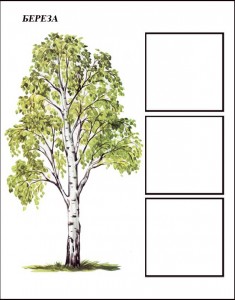

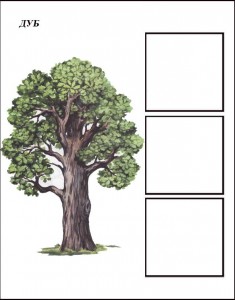


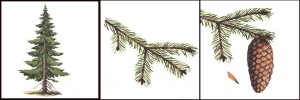


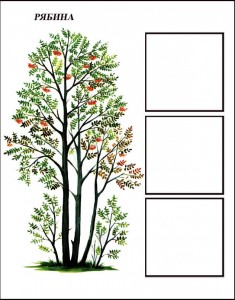

Didactic games for preschoolers on the topic: "Trees and shrubs"
Author: Knis Anna Nikolaevna, senior teacher.
Place of work: MBDOU " Kindergarten No. 3 "Smile", Kalach-on-Don.
Work description: I bring to your attention didactic games for preschoolers on the topic: "Trees and shrubs." This material will help educators, children and their parents to consolidate children's knowledge of trees and shrubs in a playful way.
Didactic game: loto "Trees and shrubs".
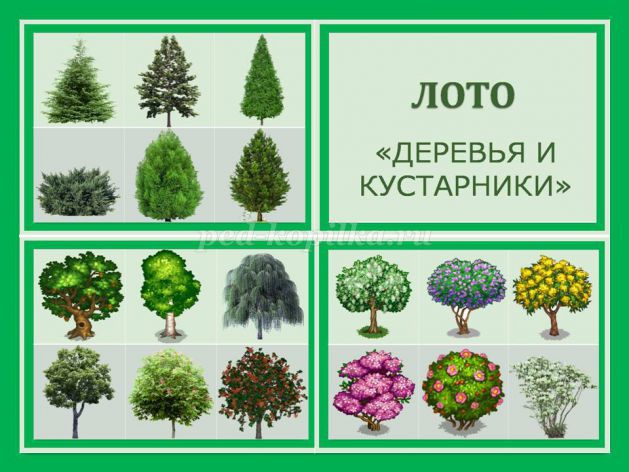
Target: Consolidation of children's knowledge about the diversity of trees and shrubs, the ability to distinguish them and find the right plant.
Didactic material: The playing field (4 pcs.), Divided into 6 squares with images various trees and shrubs corresponding to the images on small cards (24 pcs.).
Game progress: Game for children from 4 years old. The game can be played by 3-5 people. Players are given game cards. The facilitator pulls out a small card from a special opaque bag, the player or the facilitator names the tree or shrub depicted on the card. Whoever found the corresponding image on his field takes the picture for himself. This continues until one of the participants covers the entire playing field with pictures. For children from 5 years old, the game can be complicated. Name the trees or shrubs depicted on the same playing field in one word.
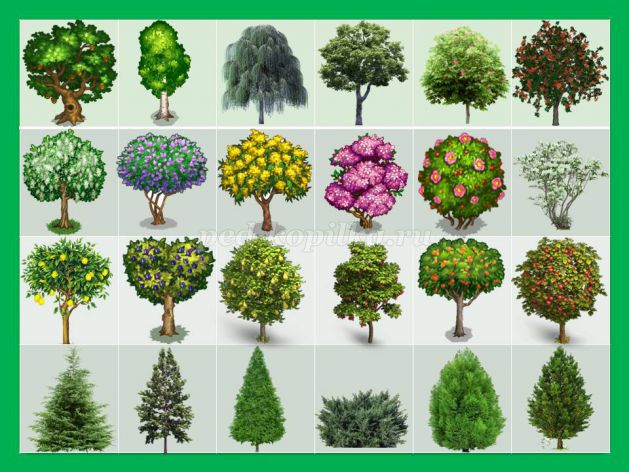
1. Oak, birch, willow, linden, chestnut, maple are deciduous trees.
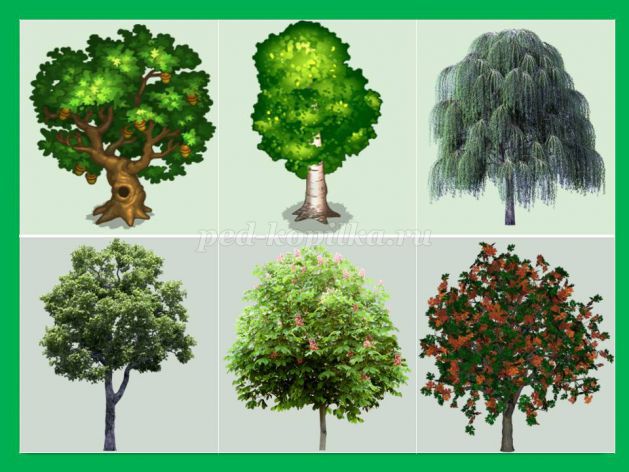
2. Bird cherry, lilac, mimosa, magnolia, wild rose, jasmine are shrubs.
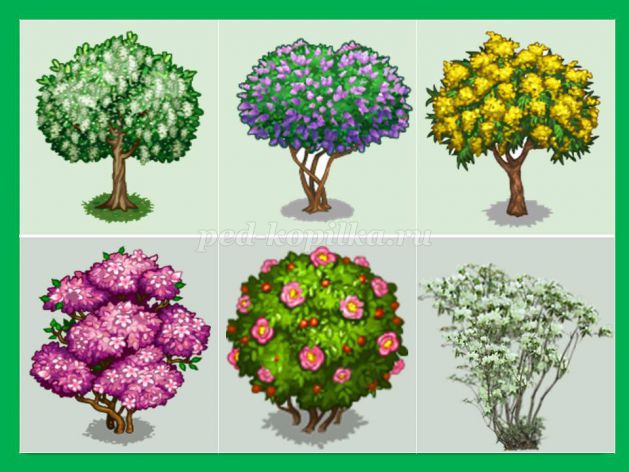
3. Lemon, plum, pear, cherry, peach, apple tree are fruit trees.

4. Spruce, pine, cypress, juniper, thuja, cedar are coniferous plants.

Didactic game "Guess the plant"
Target: Development of the ability to describe trees and shrubs and recognize them by description.
Didactic material: Cards depicting various trees and shrubs.
Game progress: The teacher gives the children cards with the image of trees and shrubs. Children do not show their cards to anyone. The teacher offers one child to describe what is shown in his picture, or to make a riddle. The other children must guess what is in the picture.
For example: This is a tree. It has white bark with black stripes. Branches hang down. In the spring, sticky buds swell on them and earrings appear. This tree is considered a symbol of Russia. (Birch).
I have longer needles
Than the tree.
I'm growing very straight
In height.
If I'm not on the edge,
Branches only at the top. (Pine).
Didactic game "Collect a picture"
Target: Development logical thinking, outlook, cognitive interest and speech activity.
Didactic material: Cards showing trees and bushes, cut into several parts.
Game progress: Game for children from 4 years old. Children are given game cards cut into 3, 4, 5 parts (according to the age and abilities of the child). Having collected the picture, the child tells what he has collected.
For example: Oak is a tree. Acorns grow on it.
Lilac is a bush with lilac flowers.
Cards for cutting.
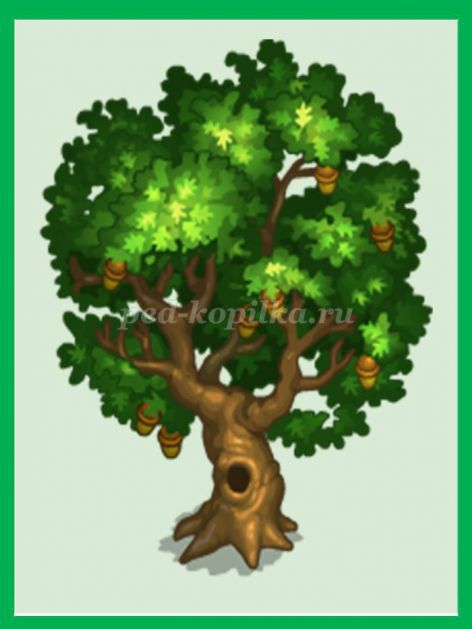
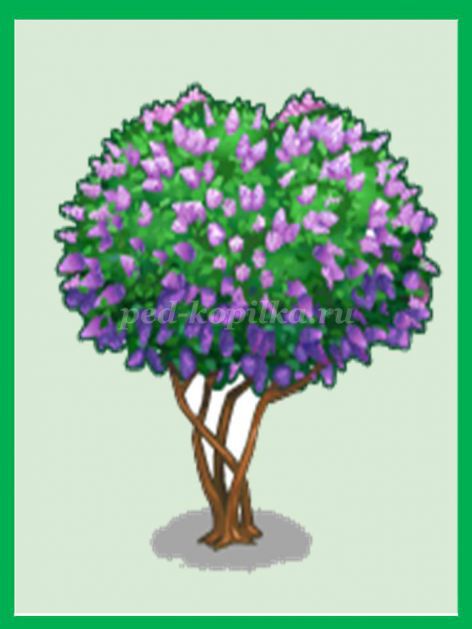
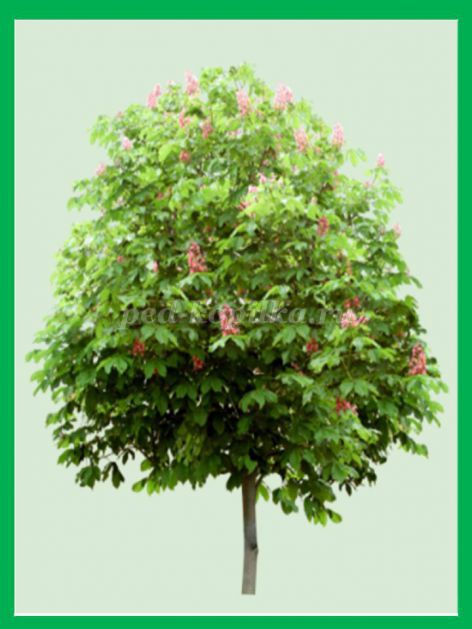
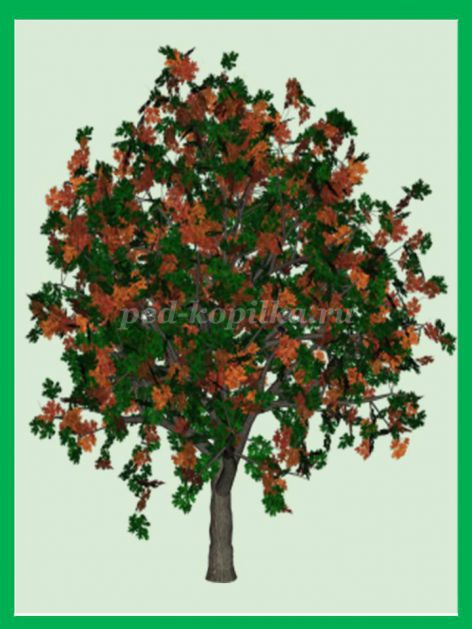
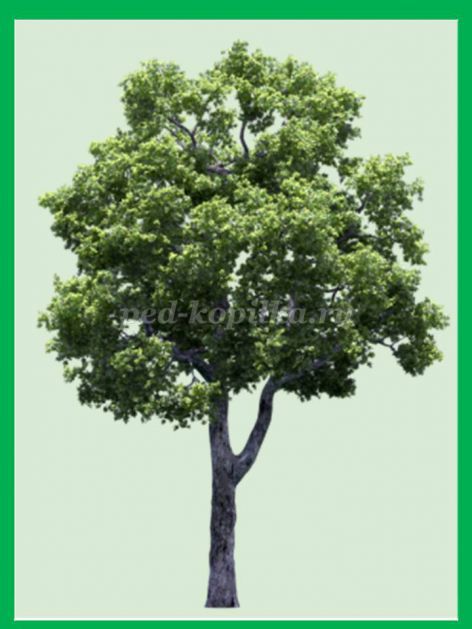

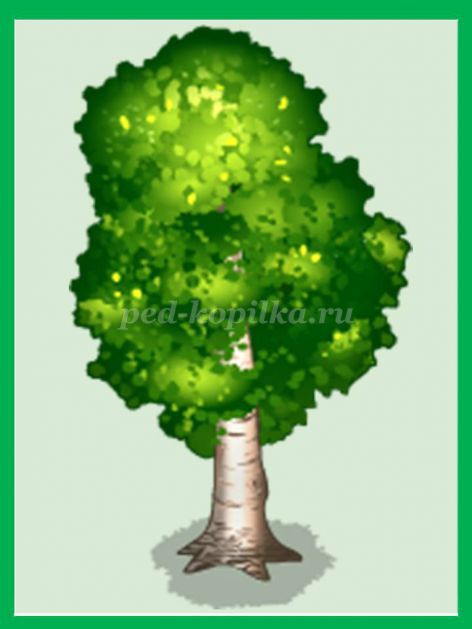


![]()
Didactic game "The Fourth Extra"
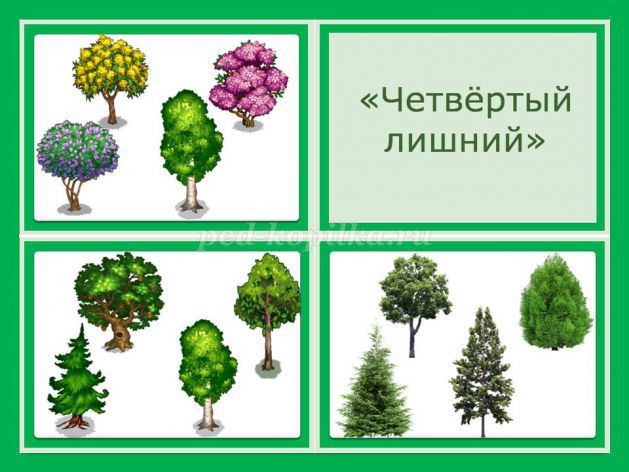
Target: Development of skills to classify trees and shrubs according to essential features.
Didactic material: Cards depicting 4 types of trees and shrubs, 3 of them belong to the same thematic group, and the fourth to another group.
Game progress: The children are given the task: “Look at the pictures, name what is shown on them and determine which image is superfluous. Remaining, name the images in one word. Each participant eliminates the extra image in turn. If he makes a mistake or does not complete the task, his version is offered to the next player. For each correctly completed task, they give a chip. The one with the most chips wins.
For example:
1. Oak, alder, spruce and birch. An extra spruce because it is a coniferous tree, and the rest are deciduous.
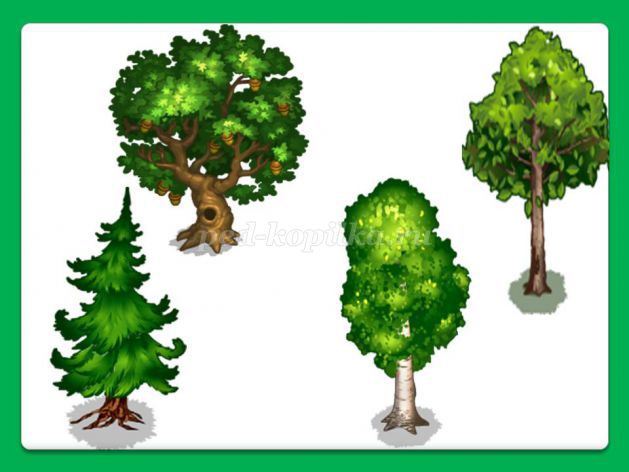
2. Alder, thuja, spruce, pine. An extra alder because it is a deciduous tree, and the rest are conifers.
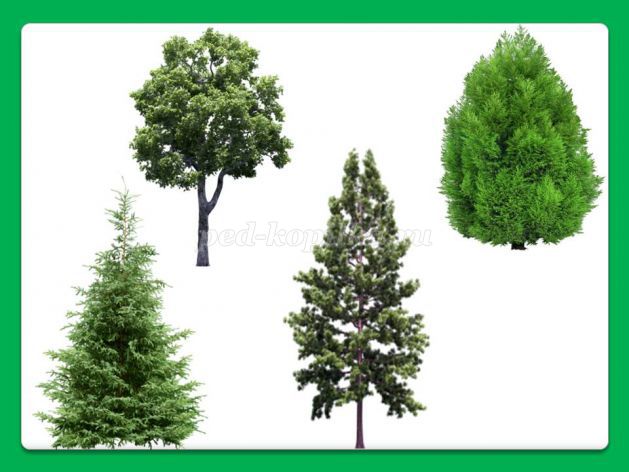
3. Pear, peach, lilac, apple tree. Extra lilac because it is a shrub, and the rest are fruit trees.
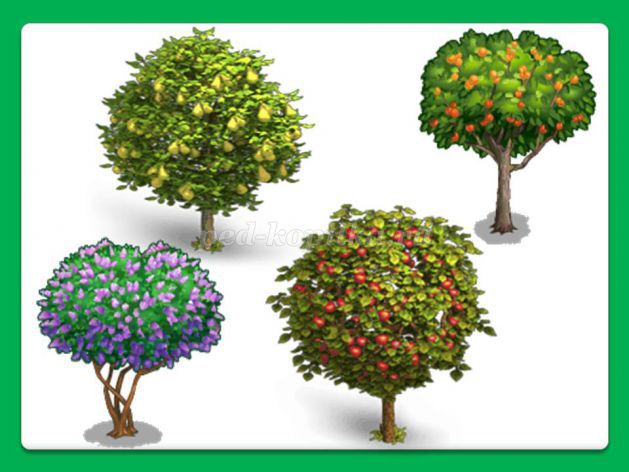
4. Mimosa, magnolia, lilac, birch. An extra birch because it is a tree, and the rest are shrubs.
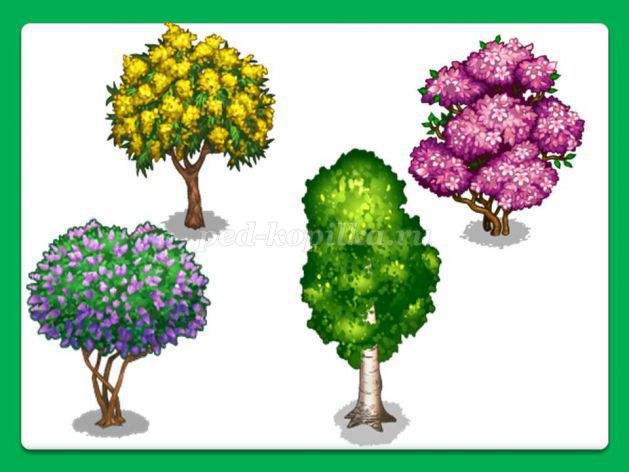
Didactic game "What first, what then?"
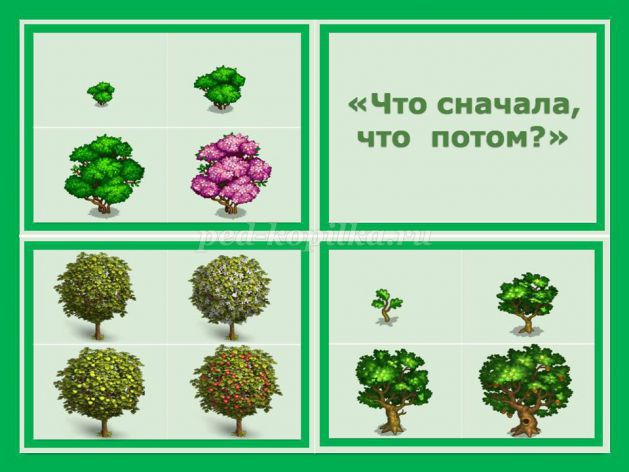
Target: the ability to arrange pictures in the order of the development of the plot.
Didactic material: A set of pictures for the game "What first, what next?", four pictures in each series.
Game progress: The teacher offers the children a series of pictures (four pictures for each child), which need to be carefully considered and determined what happened first, what then. "Which picture is the first? What was first? Children look at the pictures and put them in the correct order. To check the correctness, you can stick numbers on the back of the pictures. When the child lays out the sequence, he can check it himself by opening the pictures with reverse side.

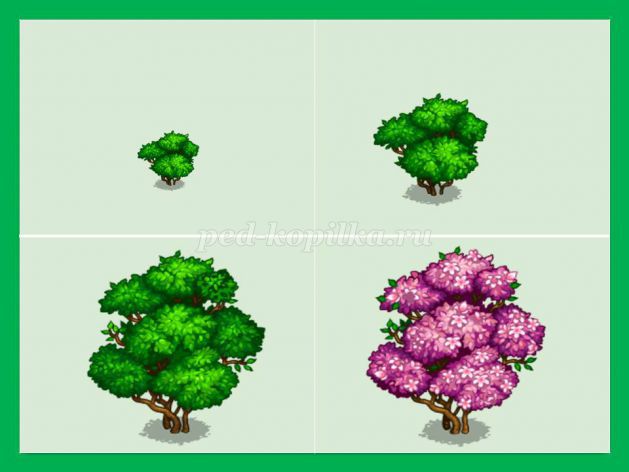
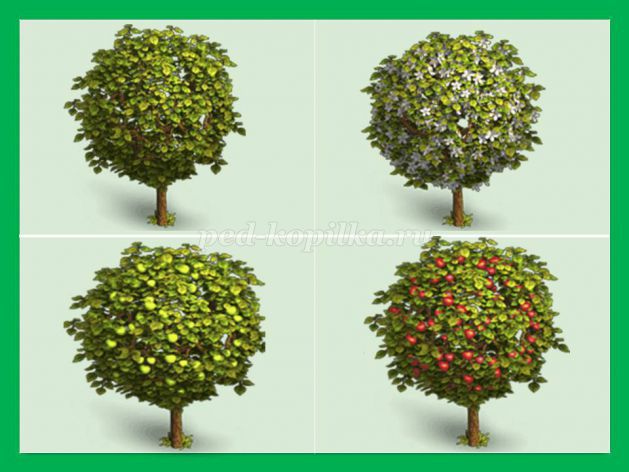

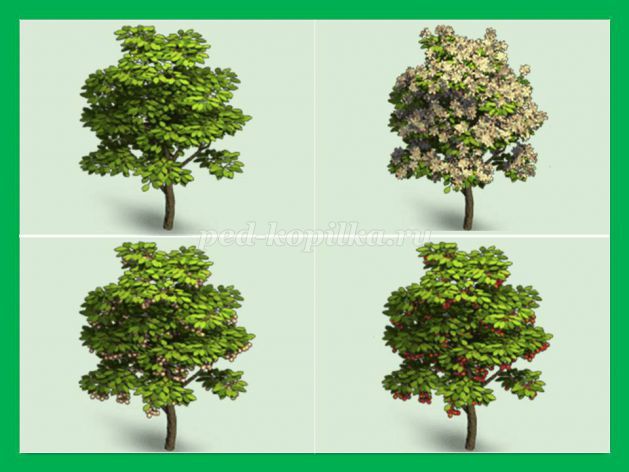
Didactic game "From which tree is the leaf?"
Target: the ability to distinguish and name the leaves of familiar trees.
Didactic material: Cards with the image of 4 types of trees and 4 leaves corresponding to these trees.
Game progress: Invite the child to connect the leaves with the trees of the corresponding type and name them.
1. Trees: cherry, peach, apple, pear.
Leaves: cherry, apple, pear, peach.
